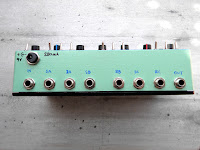This is Version 3.0. (June 2023). Headphones output with volume control has been added.
This is an all analog Stereo Parallel Blender that offers three independent parallel loops with tails capability, stereo/mono selection, dry blend, master volume control and an indepedent Headphones-out with volume control. Every loop has its own dedicated footswitch, Send/Return volume knobs, EQ, and phase reverse.
The device is also equipped with a bypass fotoswitch and is able to handle signals varying from instrument level up to higher line level (~24Vpp max) All jacks are TRS. The device is compatible with mono signals as well. Mono FX-Loops can be combined wth Stereo FX-Loops (check below)
Function explanation:
- The signal is taken from the INPUT and is split into four separate signals.
- One is send to Loop-A (SND-A), one to Loop-B (SND-B), one to Loop-C (SND-C) while the fourth is the DRY signal whose volume is controlled by the DRY-knob
- The volume of each SEND signal is controlled by its respective SND knob
- The signal from the Loop-Return (RTN-A, RTN-B, RTN-C) is then fed back to the device: first through the Phase Select section, then to the EQ and then to the RTN volume knob which sets the level of the blend.
- The EQ knob when positioned at center, has no effect. Turn the knob anti-clockwise for a darker signal (more bass). Turn the knob clockwise for a brighter signal (more treble).
- The three Loop-Return signals are then mixed together with the DRY signal and sent to the OUTPUT whose level is set by the Master Volume knob.
- NEW FEATURE: A headphones output [3.5mm (1/8'')] with its own dedicated volume control has been added in this version.
- The footswitch on the bottom right corner is used to engage or fully bypass the device.
- The A,B,C footswitches are used to mute/engage the respective loop.
- The TAILS switches offer you the option to choose if the footswitches will mute the SEND or the RETURN of each loop, giving you the option to keep the TAILS of your signal active indefinitely.
- Four switches (M/ST) on the top let you choose if the Input and each loop separately (A,B,C) will work in STEREO or MONO mode. This helps in situations where you want to mix stereo and mono FX loops. e.g.: Let's assume that A-Loop has mono effects while B, C have stereo effects. If you tried to mix them then the return signal of the A-Loop would appear only on the Left channel in the master output. If you want the return signal of the mono A-Loop to appear equally on both L+R channels in the master output then you just have to flip the A switch to the mono position.
For a schematic representation of the signal flow check the flow chart below
▹ Headphones output jack is TRS [3.5mm, (1/8'')]
▹ True Bypass (via analog IC switches, requires power)
▹ Supply Voltage required: 9V DC (center negative) [Do not exceed recommended voltage!]
▹ Supply Voltage required: 9V DC (center negative) [Do not exceed recommended voltage!]
The use of a regulated/stabilized power supply that can provide at least 300mA is advised.
▹ Current draw: ~280mA ▹ Internal voltage doubler provides the necessary Dual Rail voltage, for maximum headroom.
▹ Input signal level: up to ~24Vpp
▹ Input & Return impedance: ~2MΩ
▹ Output & Send impedance: 100Ω
▹ Flat response on the whole span of the audio frequency spectrum.
▹ Master Gain: +6dB(V) [it can be changed by your request]
▹ Weight: 1.1kg (aprox.)
▹ Enclosure dimensions: 222 X 147 X 56mm (8.74 x 5.78 x 2.20 in)
▹ Current draw: ~280mA ▹ Internal voltage doubler provides the necessary Dual Rail voltage, for maximum headroom.
▹ Input signal level: up to ~24Vpp
▹ Input & Return impedance: ~2MΩ
▹ Output & Send impedance: 100Ω
▹ Flat response on the whole span of the audio frequency spectrum.
▹ Master Gain: +6dB(V) [it can be changed by your request]
▹ Weight: 1.1kg (aprox.)
▹ Enclosure dimensions: 222 X 147 X 56mm (8.74 x 5.78 x 2.20 in)

.jpg)











